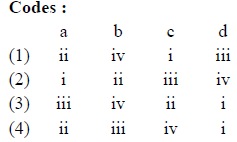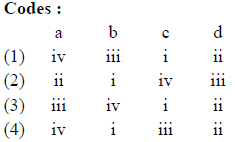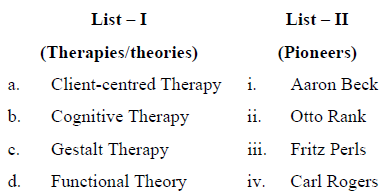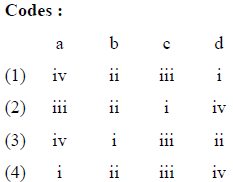SOCIAL WORK
Paper – II
Note : This paper contains fifty (50) objective type questions of two (2) marks each. All questions are compulsory.
1. The group in social group work is
(a) Systematically formed
(b) Contains specific objectives
(c) Emphasis on individual
(d) Spontaneously comes into existence
Codes :
(1) (a) only
(2) (a) and (b) only
(3) (a), (b) and (c) only
(4) (a), (b), (c) and (d)
2. “Conscientisation” approach in community organization is
(1) Providing services
(2) Praxis
(3) Organising people at mass level
(4) Understanding community for research
3. Which among the following is not correct with regard to counselling ?
(1) In counseling, no concrete help is provided but only guidance is provided to solve his/her problem.
(2) Counselling is a process.
(3) Counselling aims at enabling individuals to solve present problems to prepare them for future tasks.
(4) Counsellor assists the counsellee to make interpretations of facts relating to a choice, plan or adjustment.
4. The sum of the deviations of all the values of X from their arithmetic mean is
(1) Maximum
(2) Minimum
(3) Zero
(4) One
5. Relationship between Mean, Median and Mode in a asymmetrical distribution is
(1) Median = 3 Mode – 2 Mean
(2) Mean = 2 Mode – 3 Median
(3) Mean = 3 Median – 2 Mode
(4) Mode = 3 Median – 2 Mean
6. The household division of labour remains gendered which means that
(1) The distribution of household work between men and women is equal.
(2) Women do the lion’s share of unpaid labour within households.
(3) There is an increasing entry of women in labour force.
(4) The labour force comprises of equal number of both the sexes.
7. Probation of Offenders Act was passed in India in the year
(1) 1958
(2) 1960
(3) 1963
(4) 1986
8. Which one of the following categories of Fundamental Rights incorporates ‘Abolition of Untouchability’ ?
(1) Right to Freedom of Religion
(2) Right to Equality
(3) Right to Freedom
(4) Right against Exploitation
9. Which of the following are the main processes of performance appraisal ?
(1) Identification, Measurement, Management
(2) Assessment, Direction, Development
(3) Recruitment, Selection, Onboarding
(4) Skill, Efforts, Responsibility
10. Grouping of similar types of work in an organization is known as
(1) Job Classification
(2) Job Design
(3) Job Evaluation
(4) Job Description
11. The theory of delinquent subculture was first articulated by
(1) Albert Cohen
(2) Merton
(3) Wilson
(4) Jeffrey
12. Blocking a wish or desire from expression is termed as
(1) Denial
(2) Repression
(3) Projection
(4) Regression
13. The sexual division of labour reappears in the labour market implying that
(i) women are working in those very jobs they used to do at home.
(ii) these jobs are low status and low paid with patriarchal relations intact.
(iii) the shift is from family-based to industrially-based patriarchy.
Codes :
(1) (i) only
(2) (i) and (ii) only
(3) (i), (ii) and (iii)
(4) (i) and (iii) only
14. Self esteem is a
(1) Personality
(2) Norm
(3) Trait
(4) Ritual
15. Bhoodan took place first in
(1) Lingampalli
(2) Pochampalli
(3) Surat
(4) Ernakulam
16. In case of negatively skewed distribution
(1) Mean > Median > Mode
(2) Mean > = Median > = Mode
(3) Mean < Median < Mode
(4) Mean = Median = Mode
17. Biological school of thought on crime was proposed by
(1) Dunhum
(2) Jock Young
(3) Lambroso
(4) Ferri
18. Which among the following is associated with labelleing theory in crime ?
(1) Howard Becker
(2) Lambroso
(3) Sutherland
(4) Ferri
19. What is the number of proposed indicators to compliance of Development Agenda title as Transforming our World adopted in U.N. General Assembly ?
(1) 310
(2) 315
(3) 290
(4) 304
20. Effective time management is
(i) Plan long term
(ii) Plan short term
(iii) Make to-do list
(iv) Deligate tasks to other
Codes :
(1) (iii) and (iv)
(2) (ii), (iii) and (iv)
(3) (ii) and (iv)
(4) (i), (iii) and (iv)
21. Which of the following are methods of resolving disagreements ?
(i) Coercion
(ii) Altruistic concession
(iii) Mapping an issue
(iv) Avoidance
Codes :
(1) (iii) and (iv) (2)
(ii), (iii) and (iv)
(3) (i), (iii) and (iv)
(4) (i), (ii) and (iii)
22. The term ‘half-widows’ is understood as
(1) Woman whose husbands have disappeared but not declared dead.
(2) Women who have been victims of child marriage.
(3) Women whose husbands are dead but their bodies not traced.
(4) Women availing pension on behalf of their husbands.
23. Project proposal includes
(i) Challenges faced by the organization
(ii) Objectives of the project
(iii) Budget
(iv) Liabilities
Codes :
(1) (i) and (ii) only
(2) (ii) and (iii) only
(3) (i), (iii) and (iv) only
(4) (i), (ii) and (iii) only
24. Special homes as per the J.J. Act, 2016 are meant for
(1) Street children
(2) Orphaned children
(3) Children in conflict with law
(4) Neglected children
25. Metacommunication relates to
(1) Verbal behaviour
(2) Non-verbal cues
(3) Verbal and non-verbal behaviour
(4) Para language
26. When synergy takes place and develops ;
(1) Team members adopt conservative ideas
(2) Team members take up tasks passionately
(3) Team members introspect themselves
(4) Team members reallocate their job roles
27. Which are the elements that decide whether a person or an action is abnormal ?
(a) Suffering
(b) Violation of standards
(c) Loss of control
(d) Insecurity
Codes :
(1) (a), (b), (c) and (d)
(2) (a), (b) and (c) only
(3) (a) and (b) only
(4) (a) only
28. Disorders of Traits are known as
(1) Personality disorders
(2) Anxiety disorders
(3) Sexual disorders
(4) Obsessive-compulsive disorders
29. Which scale is used to determine the relative intensity of different items ?
(1) Thurston scale
(2) Likert scale
(3) Guttman scale
(4) Bogardus scale
30. Who is responsible for programme planning in the practice of social group work ?
(1) Group worker
(2) Agency officials
(3) Members of the group with the guidance from the group worker
(4) Group leader
31. What is the relationship between community organization and community development ?
(1) The two have nothing in common.
(2) Community development is currently used mainly in relation to rural areas of less developed countries whereas community organization is used in areas in which levels of living are relatively high with well developed social service.
(3) Both terms are often used interchangeably.
(4) Community development is a field in which community organization is practiced by professionally trained community organisers.
32. Which of the following is not a skill needed for social group worker in the practice of social group work ?
(1) skill in dealing with group feelings
(2) skill in programme development
(3) skill in participation
(4) skill in evaluation
33. Direct physical action model of social action is a form of
(1) Elitist form of social action
(2) Popular form of social action
(3) Conscientization form of social action
(4) Legislative form of social action
34. Thomas A. Harris describes the four possible life positions in transactional analysis that one takes about oneself and others. Arrange these positions in the sequence as described by him.
(i) I am not OK – You are OK
(ii) I am OK – You are OK
(iii) I am not OK – You are not OK
(iv) I am OK – You are not OK
Codes :
(1) (i) (iii) (iv) (ii)
(2) (i) (ii) (iii) (iv)
(3) (iv) (iii) (ii) (i)
(4) (ii) (i) (iii) (iv)
35. The proper sequence of the steps in the Contact Phase of the Compton and Galaway’s Problem Solving Model is
(1) Problem identification, Exploration, Contract, Goal identification
(2) Problem identification, Goal identification, Contract, Exploration
(3) Exploration, Contract, Problem identification, Goal identification
(4) Goal identification, Problem identification, Contract, Exploration
36. Arrange the following commissions in sequence as per the year of establishment starting from the earliest to the later :
(i) Central Information Commission
(ii) National Commission for Safai Karamcharis
(iii) National Commission for Women
(iv) National Commission for Backward Classes
Codes :
(1) (i) (ii) (iii) (iv)
(2) (iii) (iv) (ii) (i)
(3) (ii) (iv) (iii) (i)
(4) (iv) (iii) (i) (ii)
37. Match List – I with List – II and select the correct answer with the help of codes given below :


38. Match List – I with List – II and select the correct answer with the help of codes given below :


39. Match List – I with List – II and select the correct answer with the help of codes given below :


40. Match List – I with List – II and select the correct answer with the help of codes given below :


41. Assertion (A) : The divorce rate in India is lesser than the Western Countries.
Reason (R) : The rate of divorce will remain lesser in India due to socio-cultural ethos prevalent.
Codes :
(1) (A) is correct and (R) is false.
(2) Both (A) and (R) are false.
(3) Both (A) and (R) are correct and (R) is the correct explanation of (A).
(4) Both (A) and (R) are correct but (R) is not correct explanation of (A).
42. Assertion (A) : When people are disabled by disease, stress is placed, in turn, on family members and others who support and sustain them.
Reason (R) : Social workers address all relevant systems – biological, social and psychological that influence a person’s situation.
Codes :
(1) Both (A) and (R) are true and (R) is correct explanation of (A).
(2) Both (A) and (R) are true and (R) is not the correct explanation of (A).
(3) (A) is true and (R) is false.
(4) (A) is false and (R) is true.
43. Assertion (A) : In India, people with mental disorders suffer from stigma.
Reason (R) : Many Indians are conservative and orthodox.
Codes :
(1) (A) and (R) are correct and (R) is the correct explanation of (A).
(2) (A) is correct and (R) is not correct.
(3) Both (A) and (R) are not correct.
(4) (A) is not correct and (R) is correct.
44. Assertion (A) : Working with families helps in social work practice.
Reason (R) : Social workers must understand family background of client.
Codes :
(1) Both (A) and (R) are incorrect.
(2) Both (A) and (R) are correct but (R) is not the correct explanation of (A).
(3) Both (A) and (R) are correct and (R) is the correct explanation of (A).
(4) (A) is not correct but (R) is correct.
45. Assertion (A) : For changing a system, the group must have access to strategic people or sub-groups within the system.
Reason (R) : Group leadership must have competence to handle opinion makers.
Codes :
(1) Both (A) and (R) are not correct.
(2) (A) is correct but (R) is not correct.
(3) (A) is not correct but (R) is correct.
(4) Both (A) and (R) are correct.
Read the passage given below and answer the following questions (46 to 50) as per understanding of the passage :
Extreme poverty is the result of permanent or long lasting forms of precariousness that undermine the capacity of individuals, families, communities and population groups. Extreme poverty cannot be overcome by material aid and capacity building alone, nor can poverty reduction initiatives be successful unless they are based on the recognition of the inherent dignity and on the equal and inalienable rights of all members of the human family.
In practice all over the world, social workers concern about poverty has increased because of their long history in working with the marginalized, or excluded, those lacking resources, scenarios which push them to poverty situations. Three dimensions of extreme poverty namely; income poverty, human development poverty and social exclusion have been central concepts in the development of social work over the past century. At the micro level of daily practice, social workers are used to dealing with poverty and also with the risk assessment, working creatively
and innovatively to help people (individuals and communities) to understand their situation and to change their behaviour and their environment, where possible.
One role that derives increased attention is community development, which requires skills in community analysis, social planning, community organizing and social action. Community development requires the ability to foster economic opportunities for area residents through work on industrial retention, local business development, job training, and placement. Another role is community practice which calls for social workers to help people to discover their own resources and their own ability to create influence and positive change. The importance of this has been underscored by realizing that poverty involves a complex set of interactions between personal characteristics and a community’s resources and opportunities.
At times the role of social workers involves making tough judgements about risk to individuals and at times they have to use their ability and influence to protect the victims of poverty from themselves or from others. Examples include situations of domestic violence, child abuse or mental health. Social workers’ long history of working with people in poverty situations and witnessing their changing behaviour illustrates the importance of integrating theory about professional values that respect people, their choices and decisions.
In this approach, community practice combines work with individuals and families with community work, focusing on enhancing resources and opportunities along with personal capacities and as individuals develop out of their poverty situations, so do communities, and the two become mutually reinforcing, creating a comprehensive and integrated model that addresses social and economic exclusion and social disintegration which is necessary for effective poverty eradication.
46. What can be best way of reducing poverty ?
(1) Providing material aid and capacity building of poor.
(2) Initiating more and more poverty reduction initiatives.
(3) Recognising the inherent dignity and rights of each members of the society.
(4) Increasing the capacity of individuals, families, communities and population groups.
47. At micro level, the social workers deal with poverty issues by
(1) Helping people understand their situations and change their behaviour and environment to the extent possible.
(2) Being creative and innovative in helping people.
(3) Increased attention to community development.
(4) Developing skills in community analysis, social planning, community organization and social action.
48. What is the central idea emphasized in poverty reduction ?
(1) Community development along with fostering economic opportunities.
(2) Community practice and help people discover resources.
(3) Emphasis to use the ability of people and protect them from being victims of poverty.
(4) Community practice combined with individuals and families with community work focusing on enhancing resources and opportunities.
49. In community practice role, the social workers lay emphasis on
(1) viewing poverty as complex set of interactions between personal characteristics and community’s resources and opportunities.
(2) Help people discover their own resources.
(3) Help people discover their own ability to create influence and possible change.
(4) Importance on personal characteristics of individuals and community resources and opportunities.
50. In the context of this paragraph, which of the following cannot be a role of social workers in poverty reduction ?
(1) Provisioning materials aid to the victims of poverty.
(2) Community Development
(3) Community Practice
(4) Tackling issues of domestic violence, child abuse or mental health.
Latest Govt Job & Exam Updates: